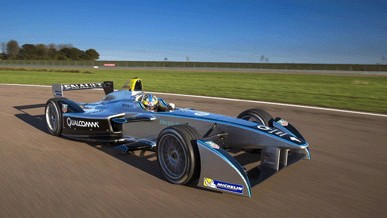The Formula E series is revving up for its inaugural race in Beijing and on Tuesday this week I attended final pre-season tests at Donington race track, along with a several thousand members of the public who saw e.dams-Renault’s Sebastien Buemi set the fastest lap time of 1:31.792 .
What is it about Formula E that piqued the interest of racing fans? Making the event free to attend will have helped, along with it being the schools summer holiday.
The new series also brings a considerable amount of racing pedigree and names such as Senna, Andretti, Prost, Piquet and Trulli will no doubt add a frisson of glamour the burgeoning race series.

The cars themselves are an exercise in low-profile aerodynamics and – contrary to popular belief – they do make a sound as they tear around the track at speeds of up to 140mph.
For some, however, sound is an issue and it makes me wonder if people are missing the point. Yes, the cars look like their petrol hungry cousins in F1 but they are powered by a battery and not a 1.6-litre V6 turbo engine. As my colleague Stuart Nathan on the features desk said earlier today, ‘if you really find the small of hydrocarbons and loud noise so exciting, go and stand next to some roadworks while we watch the racing.’
Andretti Autosport’s Franck Montagny seemed to be on the verge of quiet exasperation too when asked if his FE cars compared to any others he’s raced in, politely but unequivocally dismissing any comparisons with F1 motor racing.
‘It’s not right to compare F1 and FE because it’s taken decades to develop F1,’ he said during a Q&A session. ‘What car does it compare to? None. It’s got four wheels. It looks like a normal racing car but its not. Its very heavy on the back, the tyres are also very different – it’s a special development… so it’s very difficult to compare it.’
He concluded that maybe, in a decade from now, the FE cars may evolve to a point where they can be compared with F1 cars but the bottom line is this: right now they are different cars that bring with them a whole new racing philosophy.
As we’ve mentioned numerous times in The Engineer, Formula E will – amongst other things – act as a showcase for low-carbon vehicle technologies both on and off the track. The safety cars for the inaugural season will be fitted with Qualcomm Halo wireless charging technology and Business Green reports that Aquafuel will supply the championship with generators powered by glycerine, a byproduct of biodiesel that can also be produced from salt-water algae.
The race series will also reach out to a new generation of digitally connected fans who will be able to influence the outcome of races with something called FanBoost, a pre-race vote that gives the three most popular drivers a five second power boost and, according to FIA Formula E, temporarily increasing their car’s power from 150kw (202.5bhp) to 180kw (243bhp).
It is hoped that this, and other social forms of interaction via social media, will draw in younger fans and remove the traditional experience catching fleeting glimpses of the race from the stands.
Being of a certain age and not being particularly social media savvy, I have to say that I needed some convincing on this point but the drivers appear to be happy with it, including Montagny and Audi Sport Abt’s Lucas di Grassi who, along with many others, believes a new era of motorsport requires a more radical approach to interacting with the race. Simply being there just won’t do anymore.
Three Formula E races will take place in Europe next year, with London hosting on June 27. The cynics out there really should give it a go as the street race format looks like it’ll work exceptionally well, you won’t need earplugs to enjoy the spectacle and you just might be witnessing the dawn of a green automotive revolution.




Swiss geoengineering start-up targets methane removal
No mention whatsoever about the effect of increased methane levels/iron chloride in the ocean on the pH and chemical properties of the ocean - are we...